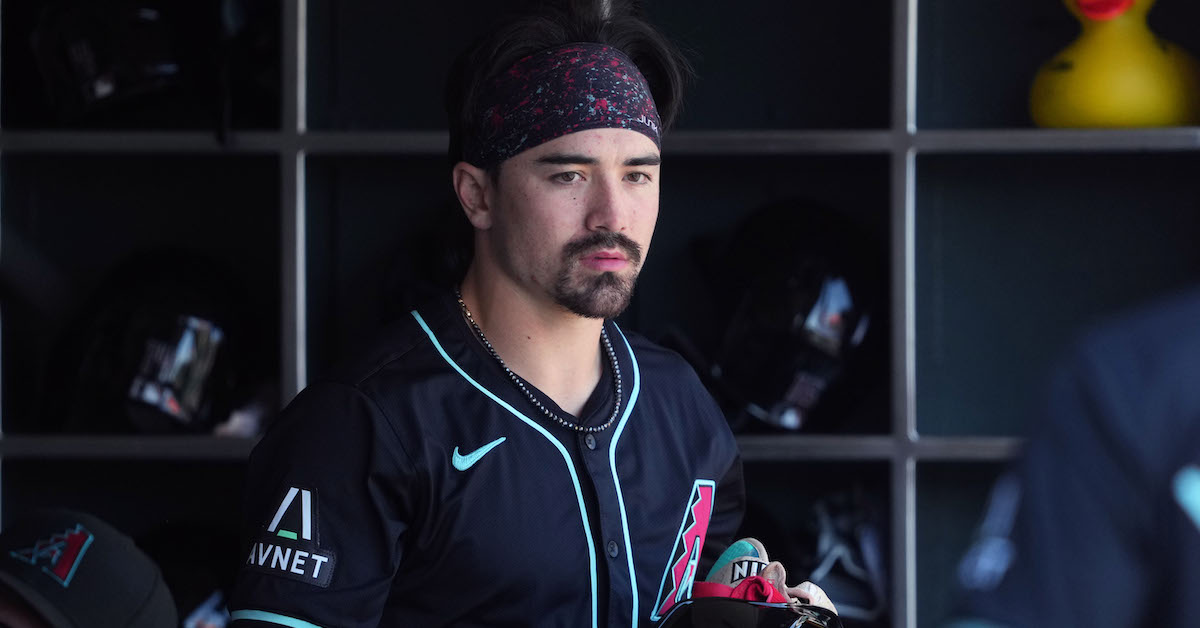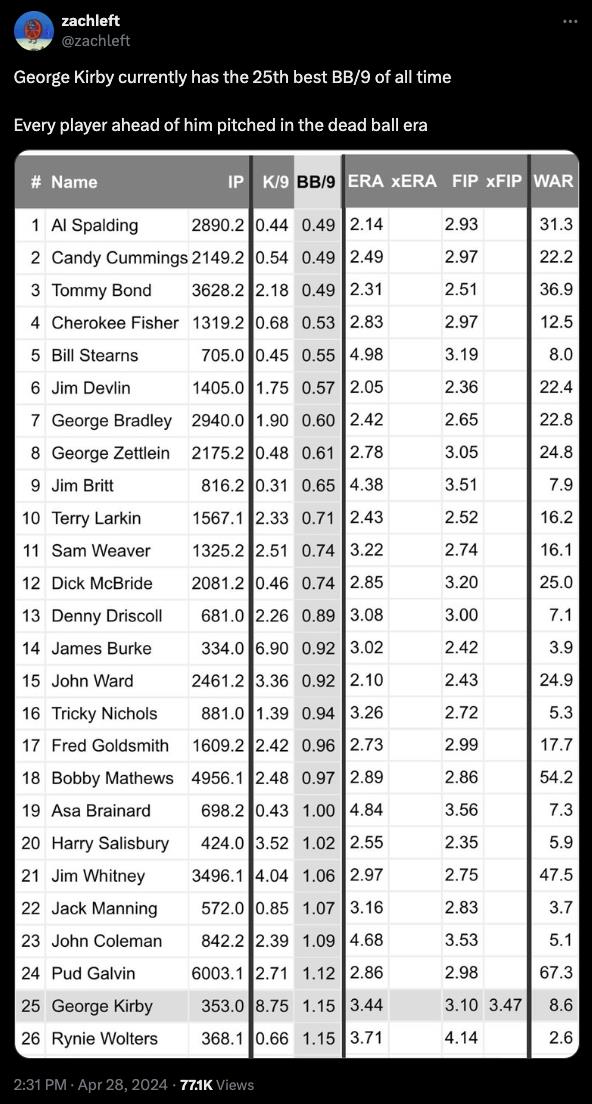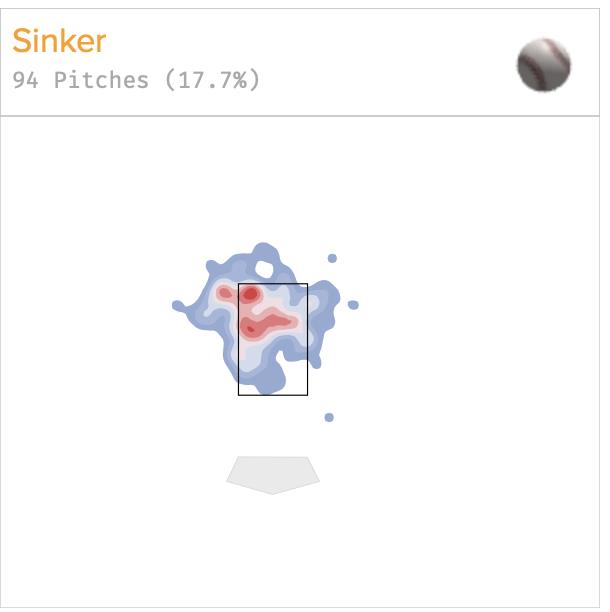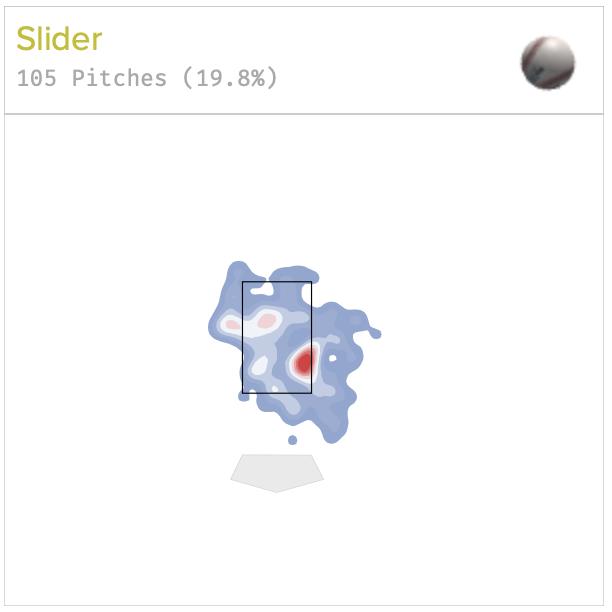
Darren Yamashita-USA TODAY Sports
Welcome back to Top of the Order, where every Monday, Wednesday, and Friday, I’ll be starting your baseball day with some news, notes, and thoughts about the game we love.
At 13-16, the Arizona Diamondbacks have started their season with something of a whimper. The biggest reason for that, in my opinion, has been the performance of Corbin Carroll, who’s gone from winning Rookie of the Year and finishing fifth in MVP voting last season to hitting just .189/.295/.236 (60 wRC+) with just one home run over 122 plate appearances. There are a couple of silver linings — he’s swiped eight bases despite his struggles and has struck out just 21 times to go along with his 15 walks — but frankly, it’s mostly been a disaster for a guy who should be playing like what he is: the most talented all-around player on the National League’s reigning pennant-winning team.
Firstly, I’ll acknowledge that Carroll perhaps overperformed last year. His batting average, slugging percentage, and wOBA were all notably higher than his expected marks, and his barrel, hard-hit, and sweet-spot rates were all in the 51st percentile or lower. Then again, his .268 xBA, .441 xSLG, and .370 xwOBA were all at or above the 65th percentile — meaning he still would’ve been solid hitter if those were his actual statistics. Moreover, with his first full season behind him, we could have reasonably expected him to improve his skills, and thus his production, as he gained experience.
So far, that hasn’t been the case. He’s been downright dreadful at the plate.
Carroll’s top-level approach is good: He’s not swinging and missing (80th percentile whiff rate) or striking out (81st percentile strikeout rate), and he’s taking his walks (84th percentile walk rate). But there’s only so much value a hitter can provide by walking and making contact if his quality of contact is abysmal, and, well, that’s pretty much the only way to describe it. His 30th-percentile barrel rate is actually his best quality of contact marker, with his percentiles for average exit velocity, hard-hit rate and sweet-spot rate all amazingly in the fourth percentile or lower. He’s basically hitting the ball with the authority of Steven Kwan and Luis Arraez; that can be totally fine for a hitter if he has the bat control that those two have (which leads to elite sweet-spot percentages), but Carroll doesn’t have that, making him punchless at the plate.
On average, Carroll is hitting the ball nearly five mph softer than he did last year. Along with that, his groundball rate has increased by nearly five percentage points. For Carroll, who has as much speed as anyone in baseball, putting the ball on the ground is far from the worst thing, but that spike in worm-killers has come at the expense of his power. Last season, he hit 25 home runs, 30 doubles and 10 triples; one homer and two doubles are his only extra-base hits this year.
When a hitter loses this much punch despite being in his early-20s, the focus, understandably, will turn to injury. Carroll has a history of scary shoulder problems, forcing him to have surgery when he was in the minors and causing him to leave a couple of games last season after painful swings. But I haven’t noticed any wincing or grimacing in the Carroll plate appearances I’ve seen this year, and he hasn’t been lifted from the lineup because of his shoulder. If there are residual issues, Carroll is keeping them private. Instead, he’s theorized that his working to cut down on strikeouts has created a deeper point of contact, which has made it harder for him to get out in front of pitches and drive them. That’s borne out in the data; his overall pull rate is down from 38.4% to 33.7%, and he’s pulling just 6.5% of fly balls compared to 27.2% last year.
This very well could be the root of his struggles: Carroll doesn’t have otherworldly raw power, so if he’s going to tap into the pop he does have — as he did last year — he’s going to need to start pulling the ball in the air again. If that means taking bigger cuts and whiffing a bit more as a result, then that’s a worthy tradeoff for him to get back to being the offensive force we know he can be.
On George Kirby and Command vs. Control
George Kirby is a fantastic pitcher, and one of my favorites to watch. The degree to which he limits walks is so unprecedented in this era that it’s almost comical. (For what it’s worth, I’m not ashamed to admit I had only so much as heard of 12 of the 24 pitchers ahead of Kirby on the list.)

It’s indisputable that Kirby has incredible control, the likes of which we haven’t seen since most pitchers were topping out at 88 mph instead of 98. If anyone breaks the 20-80 scouting scale for control, it’s Kirby. The question, though, is this: Is his command better than any pitcher since Pud Galvin retired in 1892? I would argue no.
For those unfamiliar, control is accuracy (throwing the ball in the strike zone), while command is precision (throwing the ball where you want). We’ll never know for sure where Kirby wants every pitch; there are command-based statistics that attempt to use catcher glove position to approximate, but with PitchCom allowing for more seamless communication, catchers have an easier time deking hitters who may glance back for location. But it’s hard to imagine he wants all of his sinkers where he’s putting them, even as, in fairness to him, opponents are batting just .172 against that pitch.

But they’re hitting .357 off his slider, and while Kirby’s generally able to locate it down and on the glove side, when he misses with it, he tends to leave it up and over the middle third of the plate to righties.

Pitchers aren’t robots, and even the best won’t be able to put the ball where they want all the time. Many pitchers throw the ball outside the strike zone when they miss their spots; Kirby’s misses happen within the zone. That leads to more balls in play, which makes for a more entertaining viewing experience and oftentimes a lower pitch count, but that doesn’t necessarily mean he has the best command of all time. If his command were that impeccable, considering how good his stuff is, he’d be the best pitcher in baseball by far; instead, he’s allowed nearly a hit per inning this year. Don’t get me wrong: He’s very good, one of the best starters in the league, but let’s not overrate him just because he has a lower walk rate than anyone who’s pitched since Benjamin Harrison was president.
Judge’s Hand Gives Big Inning A Head Start
In their 15-5 win on Sunday, the Yankees had a massive sixth inning that was jumpstarted in the oddest of ways. With the score knotted at four, nobody out, and Aaron Judge on first base, Alex Verdugo bounced a routine double play ball to second baseman Brice Turang, who flipped to shortstop Willy Adames, who came across the bag and fired to first. Except the ball never made it there. Instead, it deflected off the raised hand of a sliding Judge and rolled to first baseman Jake Bauers well after Verdugo reached.
After discussion on the field, the umpires elected not to call interference on Judge, which would have resulted in a double play. Verdugo was allowed to remain at first base. The next batter, Giancarlo Stanton, popped up to Turang for the second out before the Yankees rallied for seven runs. Interference is a judgment call and thus is not reviewable, but interestingly, crew chief Andy Fletcher said after the game that he believed his crew missed the call, describing the hand raising as “an unnatural part of his slide.”
Here is the rule that Fletcher said Judge violated, per the MLB rulebook: “If, in the judgment of the umpire, a base runner willfully and deliberately interferes with a batted ball or a fielder in the act of fielding a batted ball with the obvious intent to break up a double play, the ball is dead. The umpire shall call the runner out for interference and also call out the batter-runner because of the action of his teammate.”
So, according to Fletcher, interference should have been called and Verdugo should’ve been out because Judge added an unnatural act to his slide to “willfully and deliberately” break up the double play. Except, the raised hand is a natural part of Judge’s slide. “I’ve been sliding like that for years,” he said after the game. “You can look back at any picture you want of me sliding into second base.”
Indeed, I did go back and look, and I found this 2021 video of Judge sliding into second base with his hand high above his head on a stolen base.
So while this perhaps is unnatural for most, it is completely natural for Judge. Maybe this is something that opponents — and umpires — should add to their scouting report on him.
Source
https://blogs.fangraphs.com/top-of-the-order-corbin-carrolls-discouraging-start/
 Backyard GrillingWeekend WarriorsAdvice from DadBeard GroomingTV Shows for Guys4x4 Off-Road CarsMens FashionSports NewsAncient Archeology World NewsPrivacy PolicyTerms And Conditions
Backyard GrillingWeekend WarriorsAdvice from DadBeard GroomingTV Shows for Guys4x4 Off-Road CarsMens FashionSports NewsAncient Archeology World NewsPrivacy PolicyTerms And Conditions
